coolant DODGE JOURNEY 2013 1.G User Guide
[x] Cancel search | Manufacturer: DODGE, Model Year: 2013, Model line: JOURNEY, Model: DODGE JOURNEY 2013 1.GPages: 116, PDF Size: 3.43 MB
Page 71 of 116
•Your vehicle has also been equipped with a TPMS malfunction indicator to indicate when
the system is not operating properly. The TPMS malfunction indicator is combined with the
low tire pressure telltale. When the system detects a malfunction, the telltale will flash for
approximately one minute and then remain continuously illuminated. This sequence will
continue each time the vehicle is restarted as long as the malfunction exists.
•When the malfunction indicator is illuminated, the system may not be able to detect or
signal low tire pressure as intended. TPMS malfunctions may occur for a variety of reasons,
including the installation of replacement or alternate tires or wheels on the vehicle that
prevent the TPMS from functioning properly. Always check the TPMS malfunction telltale
after replacing one or more tires or wheels on your vehicle, to ensure that the replacement
or alternate tires and wheels allow the TPMS to continue to function properly.
NOTE:
Tire pressures change by approximately 1 psi (7 kPa) per 12° F (7° C) of air temperature
change. Keep this in mind when checking tire pressure inside a garage, especially in the
Winter. Example: If garage temperature is 68°F (20°C) and the outside temperature is 32°F
(0°C), then the cold tire inflation pressure should be increased by 3 psi (21 kPa), which equals
1 psi (7 kPa) for every 12°F (7°C) for this outside temperature condition.
CAUTION!
The TPMS has been optimized for the original equipment tires and wheels. TPMS
pressures and warning have been established for the tire size equipped on your vehicle.
Undesirable system operation or sensor damage may result when using replacement
equipment that is not of the same size, type, and/or style. Aftermarket wheels can cause
sensor damage. Do not use tire sealant from a can, or balance beads if your vehicle is
equipped with a TPMS, as damage to the sensors may result.
- Engine Temperature Warning Light
• This light warns of an overheated engine condition.
• If the light turns on and a warning chime sounds while driving, safely pull over and stop the vehicle. If the A/C system is on, turn it off. Also, shift the transmission into NEUTRAL
and idle the vehicle. If the temperature reading does not return to normal, turn the engine
off immediately.
• We recommend that you do not operate the vehicle or engine damage will occur. Have the vehicle serviced immediately.
WARNING!
A hot engine cooling system is dangerous. You or others could be badly burned by steam
or boiling coolant. You may want to call an authorized dealer for service if your vehicle
overheats.
WHAT TO DO IN EMERGENCIES
69
Page 74 of 116
IF YOUR ENGINE OVERHEATS
• In any of the following situations, you can reduce the potential for overheating by takingthe appropriate action.
• On the highways — slow down.
• In city traffic — while stopped, place the transmission in NEUTRAL, but do not increase engine idle speed.
NOTE:
There are steps that you can take to slow down an impending overheat condition:
• If your air conditioner (A/C) is on, turn it off. The A/C system adds heat to the engine cooling system and turning the A/C off can help remove this heat.
• You can also turn the temperature control to maximum heat, the mode control to floor and the blower control to high. This allows the heater core to act as a supplement to the
radiator and aids in removing heat from the engine cooling system.
CAUTION!
Driving with a hot cooling system could damage your vehicle. If the temperature gauge
reads HOT (H), pull over and stop the vehicle. Idle the vehicle with the air conditioner
turned off until the pointer drops back into the normal range. If the pointer remains on
HOT (H), and you hear continuous chimes, turn the engine off immediately, and call for
service.
WARNING!
You or others can be badly burned by hot engine coolant (antifreeze) or steam from your
radiator. If you see or hear steam coming from under the hood, do not open the hood until
the radiator has had time to cool. Never try to open a cooling system pressure cap when
the radiator or coolant bottle is hot.
WHAT TO DO IN EMERGENCIES
72
Page 92 of 116

FLUIDS AND CAPACITIES
Component Fluid, Lubricant, or Genuine Part Capacities
Engine Coolant–
2.4L Engine Single or Dual-Zone Climate Control System. We recommend you use
MOPAR® Antifreeze/Coolant
TenYear/150,000 Mile Formula OAT (Organic Additive Technology) 10.7 Quarts (10.1 Liters)
Includes heater and
coolant recovery bottle filled to MAX level.
Engine Coolant–
2.4L Engine Three-Zone
Climate Control System. We recommend you use
MOPAR® Antifreeze/Coolant
Ten Year/150,000 Mile Formula OAT (Organic Additive Technology) 11.6 Quarts (11.0 Liters)
Includes heater and
coolant recovery bottle filled to MAX level.
Engine Coolant–
3.6L Engine Single or Dual-Zone Climate Control System. We recommend you use
MOPAR® Antifreeze/Coolant
Ten Year/150,000 Mile Formula OAT (Organic Additive Technology) 13.1 Quarts (12.4 Liters)
Includes heater and
coolant recovery bottle filled to MAX level.
Engine Coolant–
3.6L Engine Three-Zone
Climate Control System. We recommend you use
MOPAR® Antifreeze/Coolant
TenYear/150,000 Mile Formula OAT (Organic Additive Technology) 14.5 Quarts (13.7 Liters)
Includes heater and
coolant recovery bottle filled to MAX level.
Engine Oil with Filter– 2.4L Engine We recommend you use API Certified
SAE 5W-20 engine oil, meeting therequirements of Chrysler Material Standard MS-6395. Refer to the engine oil fill cap for correct SAE grade. 4.5 Quarts (4.26 Liters)
Engine Oil with Filter– 3.6L Engine We recommend you use API Certified
SAE 5W-20 engine oil, meeting
Chrysler Material Standard MS-6395. Refer to your engine oil filler cap for correct SAE grade. 6 Quarts (5.6 Liters)
Engine Oil Filter We recommend you use MOPAR®
Engine Oil Filter —
Spark Plugs– 2.4L Engine We recommend you use MOPAR®
Spark Plugs (Gap 0.043 in [1.11 mm]) —
Spark Plugs– 3.6L Engine We recommend you use MOPAR®
Spark Plugs (Gap 0.043 in [1.1 mm]) —
Automatic Transmission We recommend you use MOPAR®
ATF+4® Automatic Transmission Fluid. Failure to use ATF+4 fluid may affectthe function or performance of your transmission. —
Brake Master Cylinder We recommend you use MOPAR®
DOT 3 and SAE J1703. If DOT 3, SAE J1703 is not available,then DOT 4 is acceptable. —
MAINTAINING YOUR VEHICLE
90
Page 93 of 116
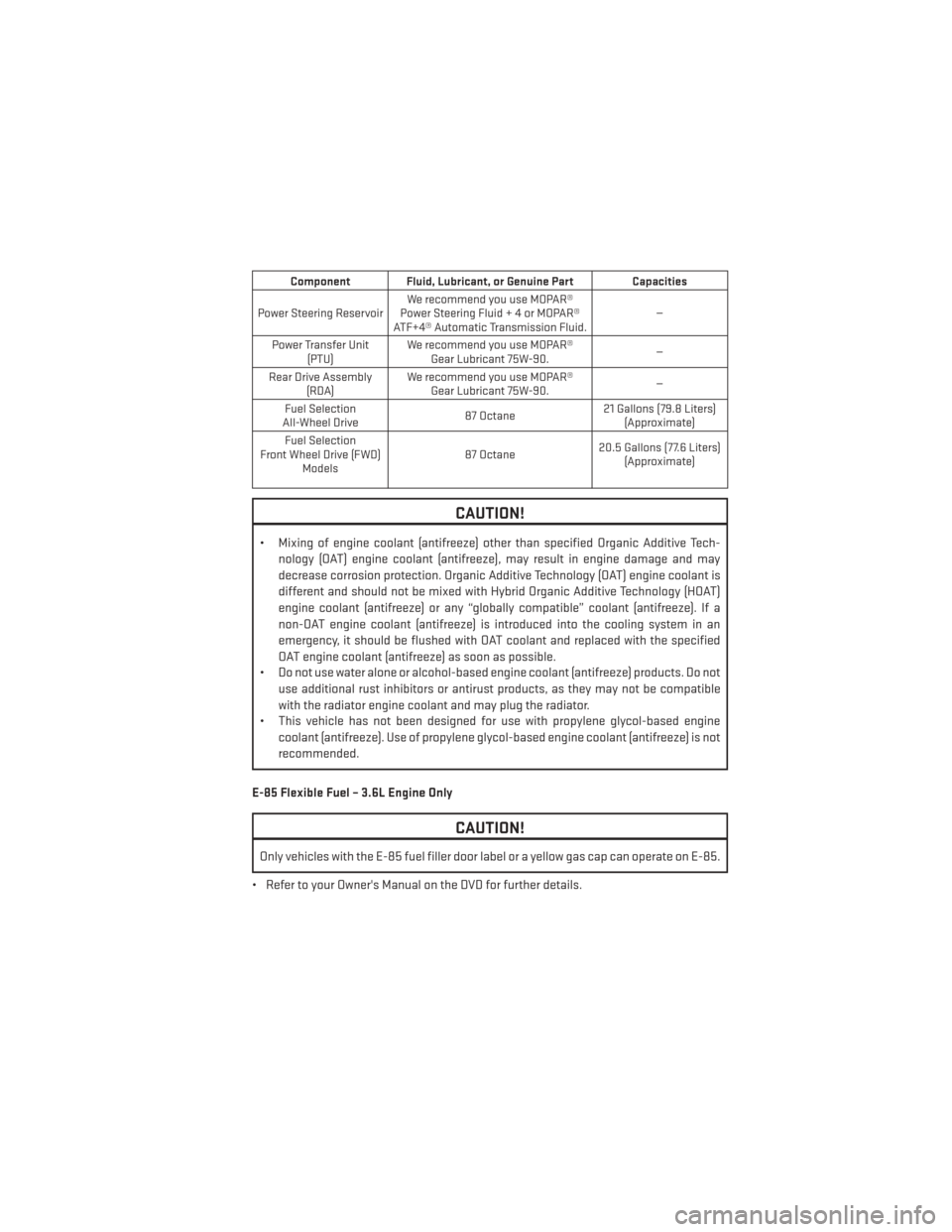
Component Fluid, Lubricant, or Genuine Part Capacities
Power Steering Reservoir We recommend you use MOPAR®
Power Steering Flui d+4orMOPAR®
ATF+4® Automatic Transmission Fluid. —
Power Transfer Unit (PTU) We recommend you use MOPAR®
Gear Lubricant 75W-90. —
Rear Drive Assembly (RDA) We recommend you use MOPAR®
Gear Lubricant 75W-90. —
Fuel Selection
All-Wheel Drive 87 Octane21 Gallons (79.8 Liters)
(Approximate)
Fuel Selection
Front Wheel Drive (FWD) Models 87 Octane
20.5 Gallons (77.6 Liters)
(Approximate)
CAUTION!
• Mixing of engine coolant (antifreeze) other than specified Organic Additive Tech-
nology (OAT) engine coolant (antifreeze), may result in engine damage and may
decrease corrosion protection. Organic Additive Technology (OAT) engine coolant is
different and should not be mixed with Hybrid Organic Additive Technology (HOAT)
engine coolant (antifreeze) or any “globally compatible” coolant (antifreeze). If a
non-OAT engine coolant (antifreeze) is introduced into the cooling system in an
emergency, it should be flushed with OAT coolant and replaced with the specified
OAT engine coolant (antifreeze) as soon as possible.
• Do not use water alone or alcohol-based engine coolant (antifreeze) products. Do not
use additional rust inhibitors or antirust products, as they may not be compatible
with the radiator engine coolant and may plug the radiator.
• This vehicle has not been designed for use with propylene glycol-based engine
coolant (antifreeze). Use of propylene glycol-based engine coolant (antifreeze) is not
recommended.
E-85 Flexible Fuel – 3.6L Engine Only
CAUTION!
Only vehicles with the E-85 fuel filler door label or a yellow gas cap can operate on E-85.
• Refer to your Owner's Manual on the DVD for further details.
MAINTAINING YOUR VEHICLE
91
Page 95 of 116
Once A Month Or Before A Long Trip:
• Check engine oil level
• Check windshield washer fluid level
• Check the tire inflation pressures and look for unusual wear or damage
• Check the fluid levels of the coolant reservoir, brake master cylinder, power steering andtransmission as needed
• Check function of all interior and exterior lights
Required Maintenance Intervals.
Refer to the maintenance schedules on the following page for the required maintenance
intervals.
At Every Oil Change Interval As Indicated By Oil Change Indicator System:
• Change oil and filter.
• Rotate the tires. Rotate at the first sign of irregular wear, even if it occurs before the oil
indicator system turns on.
• Inspect battery and clean and tighten terminals as required.
• Inspect automatic transmission fluid if equipped with dipstick.
• Inspect brake pads, shoes, rotors, drums, hoses and park brake.
• Inspect engine cooling system protection and hoses.
• Inspect exhaust system.
• Inspect engine air cleaner if using in dusty or off-road conditions.
MAINTAINING YOUR VEHICLE
93
Page 96 of 116
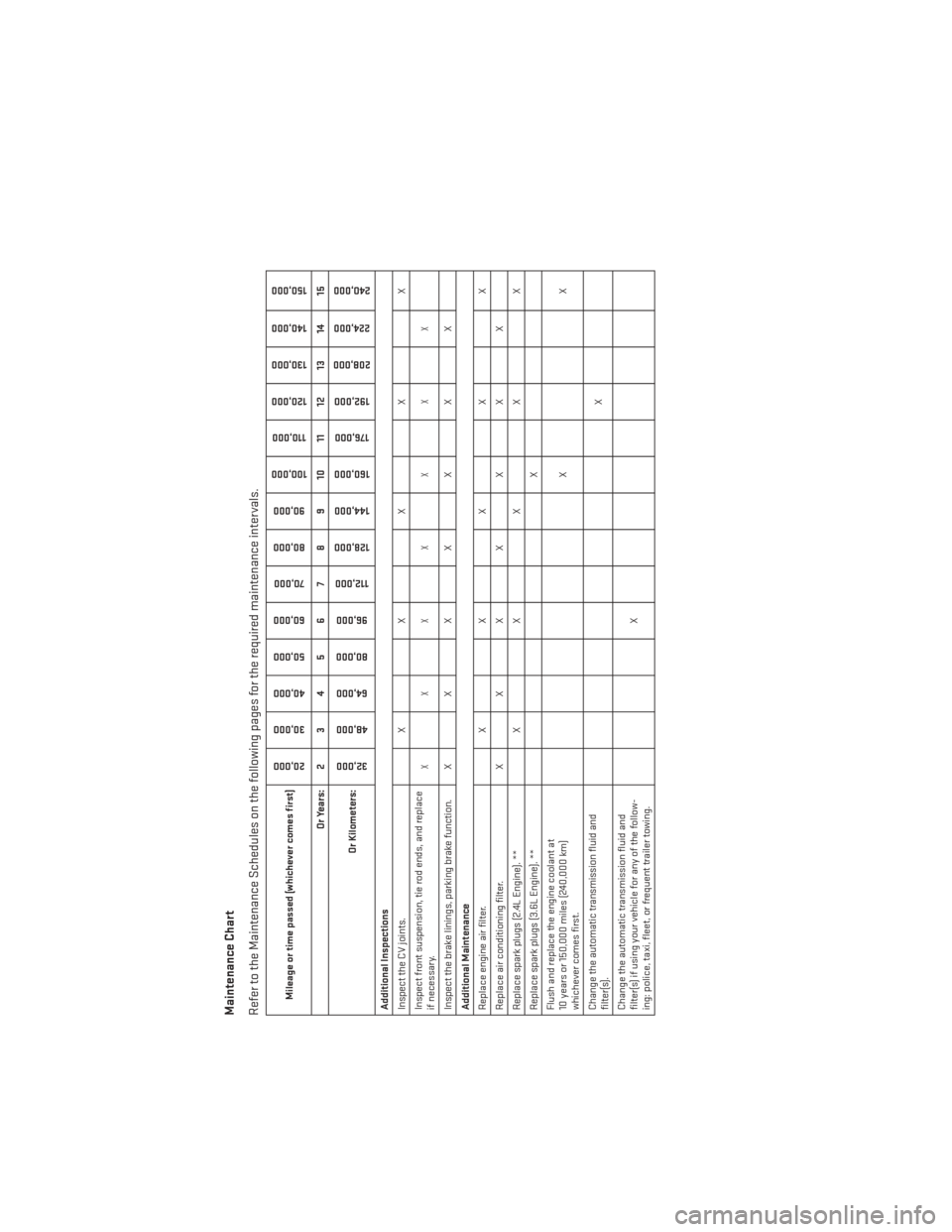
Maintenance Chart
Refer to the Maintenance Schedules on the following pages for the required maintenance intervals.
Mileage or time passed (whichever comes first)
20,00030,000
40,000
50,000
60,000 70,000
80,000 90,000
100,000 110,000
120,000 130,000
140,000
150,000
Or Years: 2 3 4 5 6 7 8 9 10 11 12 13 14 15
Or Kilometers:
32,000
48,000 64,000
80,000 96,000
112,000
128,000 144,000
160,000 176,000
192,000
208,000 224,000
240,000
Additional Inspections
Inspect the CV joints. XXXX X
Inspect front suspension, tie rod ends, and replace
if necessary.
XXXXXXX
Inspect the brake linings, parking brake function. XXXXXXX
Additional Maintenance
Replace engine air filter. XXXX X
Replace air conditioning filter. XXXXXXX
Replace spark plugs (2.4L Engine). ** XXXX X
Replace spark plugs (3.6L Engine). ** X
Flush and replace the engine coolant at
10 years or 150,000 miles (240,000 km)
whichever comes first. XX
Change the automatic transmission fluid and
filter(s). X
Change the automatic transmission fluid and
filter(s) if using your vehicle for any of the follow-
ing: police, taxi, fleet, or frequent trailer towing. X
MAINTAINING YOUR VEHICLE
94
Page 107 of 116
Airbag...................14
Air Conditioning.............30
Anti-Lock Brake System (ABS) ......71
Arming Theft System (Security Alarm) ............12
Automatic Headlights ..........27
Automatic Temperature Control (ATC)...30
Automatic Transmission Fluid Type ..............90
AxleFluid.................90
Back-UpCamera.............32
Battery Charging System Light ........70
Belts, Seat .................13
Booster Seat ...............15
BrakeFluid................90
Brake System WarningLight.............70
Break-In Recommendations, New Vehicle ..............25
BulbReplacement............101
Calibration, Compass ...........60
Change Oil Indicator ............71
Changing A Flat Tire ...........73
Charging System Light ..........70
Check Engine Light (Malfunction Indicator Light) .....70
Child Booster Seat ............15
Child Restraint ..............15
Child Restraint Tether Anchors ......16
ClimateControl..............30
Compass Calibration ...........60
Cooling System Coolant Capacity ...........90
Cruise Control (Speed Control) ......28
Cruise Light ................28
Customer Assistance ..........102
Customer Programmable Features ....61
Defects, Reporting ............103
Disarming, Theft System .........12 Electronic Speed Control
(Cruise Control) ............28
Electronic Throttle Control Warning Light .............71
Electronic Vehicle Information Center (EVIC) .............60
Emergency, In Case of Freeing Vehicle When Stuck .....85
Jacking ................73
Overheating ..............72
Engine Break-In Recommendations .....25
Compartment ............88
Malfunction Indicator
(Check Engine) ............70
Oil Selection .............90
Overheating ..............72
EventDataRecorder...........86
Exterior Lights ..............101
Fluid Capacities .............90
Fluids ...................90
FogLights.................27
Folding Front Passenger Seat .......19
Folding Rear Seat .............20
Freeing A Stuck Vehicle .........85
Front Heated Seats ............22
Fuel Specifications ............90
Fuse....................97
Fuses...................97
Garage Door Opener (HomeLink®) ....62
Headlights Automatic ..............27
HeatedMirrors ..............31
Heated
Seats...............22
Heated Steering Wheel ..........23
HomeLink® (Garage Door Opener) ....62
Hood Release ...............87
INDEX
105